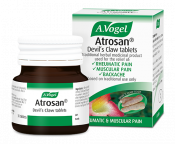1 – Try a vitamin D supplement
Vitamin D helps the body absorb calcium which keeps our bones strong and healthy. If there is an insufficient level of vitamin D, however, the body is less able to absorb this crucial mineral, leading to symptoms such as low mood, aching joints and poor digestion. As well as this, a deficiency makes adults more prone to bone fractures and osteoporosis. In contrast, research shows that a sufficient supply of vitamin D slows bone density loss which, in turn, decreases the risk of fracture.1
As vitamin D is largely obtained from exposure to the sun, this problem is common in areas where there is a limited supply of good weather, though people who do not spend enough time in the daylight, such as office workers or the elderly who are unable to get outside, are also prone to it. Faulty vitamin D receptors and poor dietary intake can also contribute to deficiency - vitamin D is found in oily fish, cheese and egg yolks, for example, so vegans and vegetarians are particularly at risk.
TOP TIP
Taking a vitamin D supplement is sensible if you have osteoporosis as it helps the body to absorb calcium, a key mineral for the bones. As they are generally better absorbed by the body, a liquid supplement is preferred.
2 - Increase magnesium intake
Magnesium is very important for those with osteoporosis as it helps calcium to be absorbed but also contributes to the conversion of vitamin D into its most active form (vitamin D, as we now know, is also very important for calcium absorption).
Magnesium deficiency, which is more common in Western countries, can be countered by eating more wholegrain foods, nuts and dried fruits, as well as by taking a magnesium supplement.
TOP TIP
Again, a liquid supplement is best as this is more easily absorbed into the bloodstream. You can find a range of suitable products in your local health food store.
3 - Address low stomach acid
Low stomach acid can arise for a number of reasons. It could be a result of age, for example, as we become less efficient at making stomach acid as we get older. Other things that contribute to the problem include stress, poor dietary choices, nutrient deficiencies and infection. Taking antacid medication long term may also lower levels of stomach acid.
Low stomach acid is a risk factor for osteoporosis as it makes it difficult for the body to solubilise and ionise calcium, which has a very important part to play in bone maintenance and health.
TOP TIP
Try using bitter herbs such as Centaurium before meals if you have any problems in this respect. This helps digestion so should be taken 5 minutes before meals.
4 – Tackle stress
Stress is a risk factor for osteoporosis because it reduces digestive ability. Low stomach acid can then arise as a result of poor digestion which, as I’ve just explained, may then affect calcium levels.
With stress often comes lack of sleep and disrupted blood glucose regulation as well. Since the latter affects bone density, this demonstrates further how stress can be a risk factor for osteoporosis.
TOP TIP
Stress Relief Daytime contains a gentle mix of Valerian and Hops to ease symptoms of mild stress and anxiety. For additional tips on how to manage stress in the long term I recommend reading some of the pieces of our stress hub.
5 – Make dietary changes
A high intake of animal protein, caffeine, processed foods and refined sugar can cause high levels of acidity in the bloodstream which is not good for the health of the bones. Instead, a diet full of fresh produce is preferred. As one particular review concluded, fruit and vegetables continue to be under-consumed, despite the fact that they provide important micronutrients and phytochemicals that are useful for bone remodelling.5
This particular review, which looked at evidence from 20 trials evaluating the role of wholefoods on bone health, also found emerging evidence to suggest that dried fruits such as prunes could help to support bone health, mainly by providing meaningful amounts of vitamin K, manganese, boron, copper and potassium.
Nutrients such as selenium, copper and iron, which can be found in a range of foods, may also have roles to play in bone health. Therefore, we should aim to eat a healthy, varied and balanced diet, particularly during sensitive windows of bone turnover such as during the menopause.
In addition, research also shows that salt intake can have an effect on calcium levels.6 When sodium intake becomes too high, the body gets rid of it via urine, however, calcium is excreted at the same time. High levels of calcium in the urine may contribute to the development of kidney stones, while inadequate levels of calcium in the body can lead to thin bones and osteoporosis. Therefore, it makes sense that if we want to improve bone health, we will have to cut down our intake of salt.
TOP TIP
Chips and crisps are the obvious culprits when it comes to high salt content but don’t forget that processed meats, ready meals, white bread and even pre-packaged sauces also contain high quantities. As an alternative to these, why not try making some homemade low salt snacks and meals instead? You can find a range of easy recipes over on our recipe hub.
6 – Avoid fizzy juice and caffeine
High quantities of fizzy juice and caffeine can reduce phosphorus levels which will not do the bones any favours. High levels of phosphate in the blood negatively affect vitamin D levels and, since this helps to absorb calcium, it can go on to weaken the bones.
TOP TIP
Swap the lemonade and cola for a refreshing smoothie – you can find a variety of recipes to suit your own tastes over on our recipe hub. If you are a coffee lover, however, our natural Bambu drink offers up an alternative, bone-friendly option given that it is absolutely free from caffeine.
7 – Do some moderate exercise
Physical exercise is also very important for strong bones and inactivity has been linked with an increased chance of osteoporosis. 20-30 minutes walking on a daily basis is a good starting point but you may also want to try some low impact sports such as swimming and golf. Your doctor will also be able to offer information on what kind of exercise classes may be suitable.
TOP TIP
Adults need around 160 minutes of exercise a week so why not do half an hour, five days a week. Our Get Active Advisor Louise has lots of advice to offer on sporting activities so browse her hub for inspiration.

Should I take calcium for osteoporosis?
We all know that calcium is beneficial for the bones, right? Did you know, however, that it is actually quite hard to become deficient in calcium as a result of your diet alone?
Individuals with an eating disorder, the elderly who have restrictions on their diet (if they can’t get out to the shops, for example, or are reliant on ready meals), and anyone using recreational drugs can be prone to the issue.
If your diet is varied, though, it is unlikely that you will become deficient in calcium as a result of what you are eating. Therefore, instead of trying a calcium supplement I would focus more on vitamin D which, as I have explained, helps calcium absorption.
Furthermore, research published in the British Medical Journal in 2015 concluded that increasing calcium intake through dietary sources and taking calcium supplements produces small, non-progressive increases in bone mineral density (BMD) which is unlikely to lead to a clinically significant reduction in the risk of fracture.7 They concluded that we need to do more than just increase our calcium intake to help the health of our bones; hence I’ve given you lots of options above!
My Top Tip:
|
References
1 Feskanich et al. Am J Clin Nutr. 2003;77(2): 504-511
2 Hiigs J, Derbyshire E and Styles K. Nutrition and osteoporosis prevention for the orthopaedic surgeon: a wholefoods approach. EFORT Open Reviews 2017; 2 (6): 300-308
3 Wanling Pan et al. Am J Physiol Renal Physiol. 2012 Apr 15; 302(8): F943-F956. Published online 2011 Sep 21. Doi: 10.1152/ajprenal.00504.2010. PMCID: PMC3330715
4 Tai V et al. Calcium intake and bone mineral density systematic review and meta-analysis. British Medical Journal 2015; 351: h4183.





 Urticalcin can improve calcium uptake which may, in turn, improve bone density and guard against osteoporosis. Urticalcin is a calcium director – it shows calcium where to go (bones, nails, hair) instead of allowing it to be dumped in joints and tissue where it is not wanted. In addition, it can speed up bone healing after fractures, help reduce cramps, strengthen nails, plus it may help restless leg syndrome.
Urticalcin can improve calcium uptake which may, in turn, improve bone density and guard against osteoporosis. Urticalcin is a calcium director – it shows calcium where to go (bones, nails, hair) instead of allowing it to be dumped in joints and tissue where it is not wanted. In addition, it can speed up bone healing after fractures, help reduce cramps, strengthen nails, plus it may help restless leg syndrome. 


